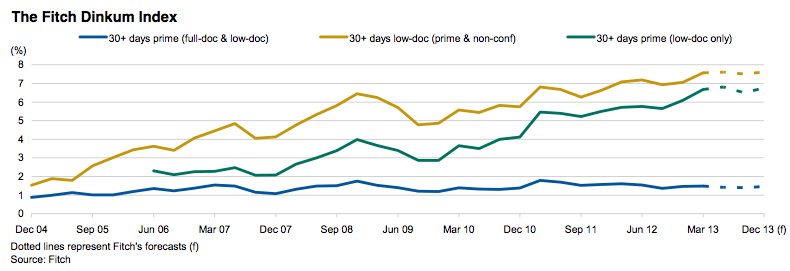
From Fitch just now:
Fitch Ratings-Sydney-19 June 2013: Fitch’s Dinkum Index, which records 30+ days delinquencies in the Australian prime RMBS sector, remained largely stable in a low interest rate environment, with 30+ days arrears increasing by 2bp to 1.48%.
Q113 saw 30-59 and 60-89 days arrears increase by 4 and 3bp respectively, while 90+ days arrears decreased by 5bps. As expected, there was a seasonal increase in arrears in Q113, as the serviceability of some Australian borrowers was temporarily affected by holiday and Christmas spending. The increase was mitigated however by a low mortgage interest rate environment and the inclusion of six new transactions to the Index, with the 30-59 days arrears recording the lowest post-Christmas level record since March 2006 at 0.59%. A further rate cut by the RBA in May 2013 is expected to benefit performance over the coming quarters.
Self-employed borrowers continued to experience stress, despite the low interest rate environment, with the Dinkum Low-Doc Index deteriorating to 7.57% in Q113, up from 7.05% in Q412. Low-doc borrowers have historically taken longer to adjust their spending and cure their delinquency status given the sector’s lumpy nature of cash flow.
Low levels of unemployment, coupled with continued low mortgage interest rates and strong GDP are expected to provide a stable macro-environment, with mortgage arrears levels remaining in line with those of 2012.
Australian delinquency rates continue to remain low relative to other countries and are well within Fitch’s expectations used to derive its ratings for Australian RMBS transactions.
Here’s the chart which looks like its rising steadily to me:


